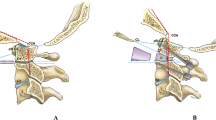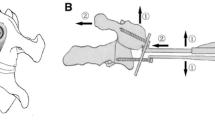Abstract
Purpose
To report the surgical technique and preliminary clinical results for the treatment of basilar invagination (BI) with atlantoaxial dislocation (AAD) by posterior C1–C2 pedicle screw and rod instrument.
Methods
Between July 2012 and August 2013, 33 patients who had BI with AAD underwent surgery at our institution. Pre and postoperative three-dimensional computed tomographic (CT) scans were performed to assess the degree of dislocation. Magnetic resonance (MR) imaging was used to evaluate the compression of the medulla oblongata. For all patients, reduction of the AAD was conducted by two steps: fastening nuts and rods was performed to achieve the horizontal reduction. Distraction between C1 and C2 screws was performed to obtain the vertical reduction.
Results
No neurovascular injury occurred during surgery. Follow-up ranged from 6 to 15 months (mean 10.38 months) in 32 patients. Post-operative three-dimensional CT showed that complete horizontal reduction was obtained in 30/33 (90.9 %), and complete vertical reduction was obtained in 31/33 (93.9 %). The repeated three-dimensional CT and MR image demonstrated that bony fusion and the decompression of the medulla oblongata were obtained in all patients. Clinical symptoms improved significantly 3 months after surgery.
Conclusions
This C1–C2 pedicle screw and rod instrument is a promising technique for the treatment of BI with AAD.



Similar content being viewed by others
References
Landeiro JA, Boechat S, Christoph DH, Goncalves MB, Castro I, Lapenta MA, Ribeiro CH (2007) Transoral approach to the craniovertebral junction. Arq Neuropsiquiatr 65:1166–1171
Wang T, Zeng B, Xu J (2011) Transoral reduction of irreducible posteriorly displaced odontoid fracture. Eur Spine J 20(Suppl 2):S227–S230
Messina A, Bruno MC, Decq P, Coste A, Cavallo LM, de Divittis E, Cappabianca P, Tschabitscher M (2007) Pure endoscopic endonasal odontoidectomy: anatomical study. Neurosurg Rev 30:189–194 discussion 194
Wu JC, Huang WC, Cheng H, Liang ML, Ho CY, Wong TT, Shih YH, Yen YS (2008) Endoscopic transnasal transclival odontoidectomy: a new approach to decompression: technical case report. Neurosurgery 63:ONSE92–ONSE94 discussion ONSE94
Chandra PS, Kumar A, Chauhan A, Ansari A, Mishra NK, Sharma BS (2013) Distraction, compression, and extension reduction of basilar invagination and atlantoaxial dislocation: a novel pilot technique. Neurosurgery 72:1040–1053 discussion 1053
Abumi K, Takada T, Shono Y, Kaneda K, Fujiya M (1999) Posterior occipitocervical reconstruction using cervical pedicle screws and plate-rod systems. Spine 24:1425–1434
Jian FZ, Chen Z, Wrede KH, Samii M, Ling F (2010) Direct posterior reduction and fixation for the treatment of basilar invagination with atlantoaxial dislocation. Neurosurgery 66:678–687 discussion 687
Ni B, Zhou F, Guo Q, Li S, Guo X, Xie N (2012) Modified technique for C1–C2 screw-rod fixation and fusion using autogenous bicortical iliac crest graft. Eur Spine J 21:156–164
Harms J, Melcher RP (2001) Posterior C1–C2 fusion with polyaxial screw and rod fixation. Spine 26:2467–2471
Goel A, Laheri V (1994) Plate and screw fixation for atlanto-axial subluxation. Acta Neurochir (Wien) 129:47–53
Lim TH, Eck JC, An HS, Hong JH, Ahn JY, You JW (1996) Biomechanics of transfixation in pedicle screw instrumentation. Spine 21:2224–2229
Goel A (2004) Treatment of basilar invagination by atlantoaxial joint distraction and direct lateral mass fixation. J Neurosurg Spine 1:281–286
Ding X, Abumi K, Ito M, Sudo H, Takahata M, Nagahama K, Iwata A (2012) A retrospective study of congenital osseous anomalies at the craniocervical junction treated by occipitocervical plate-rod systems. Eur Spine J 21:1580–1589
Wang S, Wang C, Leng H, Zhao W, Yan M, Zhou H (2012) Cable-strengthened C2 pedicle screw fixation in the treatment of congenital C2-3 fusion, atlas occipitalization, and atlantoaxial dislocation. Neurosurgery 71:976–984 discussion 984
Hsu W, Zaidi HA, Suk I, Gokaslan ZL, Wolinsky JP (2010) A new technique for intraoperative reduction of occipitocervical instability. Neurosurgery 66:319–323 discussion 323–314
Ni B, Guo X, Xie N, Li S, Zhou F, Zhang F, Liu Q (2013) C1–C2 transarticular screws combined with C1 laminar hooks fixation: a modified posterior atlantoaxial fixation technique and outcome in 72 patients. Eur Spine J 22:260–267
Ma W, Feng L, Xu R, Liu X, Lee AH, Sun S, Zhao L, Hu Y, Liu G (2010) Clinical application of C2 laminar screw technique. Eur Spine J 19:1312–1317
Yang J, Ma X, Xia H, Wu Z, Ai F, Yin Q (2014) Transoral anterior revision surgeries for basilar invagination with irreducible atlantoaxial dislocation after posterior decompression: a retrospective study of 30 cases. Eur Spine J 23:1099–1108
Krag MH, Beynnon BD, Pope MH, DeCoster TA (1988) Depth of insertion of transpedicular vertebral screws into human vertebrae: effect upon screw-vertebra interface strength. J Spinal Disord 1:287–294
Fensky F, Kueny RA, Sellenschloh K, Puschel K, Morlock MM, Rueger JM, Lehmann W, Huber G, Hansen-Algenstaedt N (2014) Biomechanical advantage of C1 pedicle screws over C1 lateral mass screws: a cadaveric study. Eur Spine J 23:724–731
Ma XY, Yin QS, Wu ZH, Xia H, Liu JF, Xiang M, Zhao WD, Zhong SZ (2009) C1 pedicle screws versus C1 lateral mass screws: comparisons of pullout strengths and biomechanical stabilities. Spine 34:371–377
Wright NM (2004) Posterior C2 fixation using bilateral, crossing C2 laminar screws: case series and technical note. J Spinal Disord Tech 17:158–162
Heuer GG, Hardesty DA, Bhowmick DA, Bailey R, Magge SN, Storm PB (2009) Treatment of pediatric atlantoaxial instability with traditional and modified Goel-Harms fusion constructs. Eur Spine J 18:884–892
Parker SL, McGirt MJ, Garces-Ambrossi GL, Mehta VA, Sciubba DM, Witham TF, Gokaslan ZL, Wolinksy JP (2009) Translaminar versus pedicle screw fixation of C2: comparison of surgical morbidity and accuracy of 313 consecutive screws. Neurosurgery 64:343–348 discussion 348–349
Jones EL, Heller JG, Silcox DH, Hutton WC (1997) Cervical pedicle screws versus lateral mass screws. Anatomic feasibility and biomechanical comparison. Spine 22:977–982
Johnston TL, Karaikovic EE, Lautenschlager EP, Marcu D (2006) Cervical pedicle screws vs. lateral mass screws: uniplanar fatigue analysis and residual pullout strengths. Spine J 6:667–672
Goel A, Sharma P (2005) Craniovertebral junction realignment for the treatment of basilar invagination with syringomyelia: preliminary report of 12 cases. Neurol Med Chir 45:512–517 discussion 518
Wetjen NM, Heiss JD, Oldfield EH (2008) Time course of syringomyelia resolution following decompression of Chiari malformation Type I. J Neurosurg Pediatr 1:118–123
Iai H, Moriya H, Goto S, Takahashi K, Yamagata M, Tamaki T (1993) Three-dimensional motion analysis of the upper cervical spine during axial rotation. Spine 18:2388–2392
Acknowledgments
This research presented in this article has not received funding from any organizations.
Conflict of interest
All authors have no personal financial or institutional financial interest in any of the drugs, materials, or devices described in the article.
Author information
Authors and Affiliations
Corresponding author
Rights and permissions
About this article
Cite this article
Guo, S.L., Zhou, D.B., Yu, X.G. et al. Posterior C1–C2 screw and rod instrument for reduction and fixation of basilar invagination with atlantoaxial dislocation. Eur Spine J 23, 1666–1672 (2014). https://doi.org/10.1007/s00586-014-3409-5
Received:
Revised:
Accepted:
Published:
Issue Date:
DOI: https://doi.org/10.1007/s00586-014-3409-5




